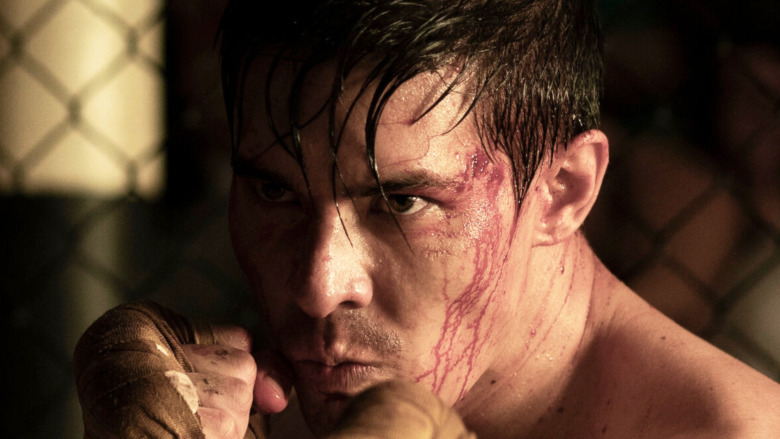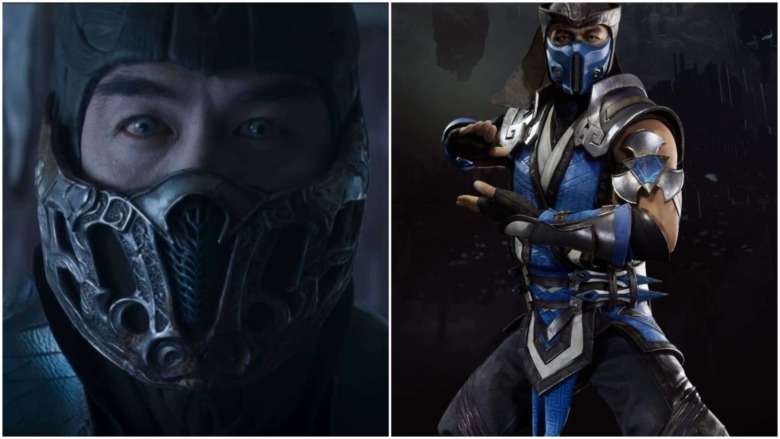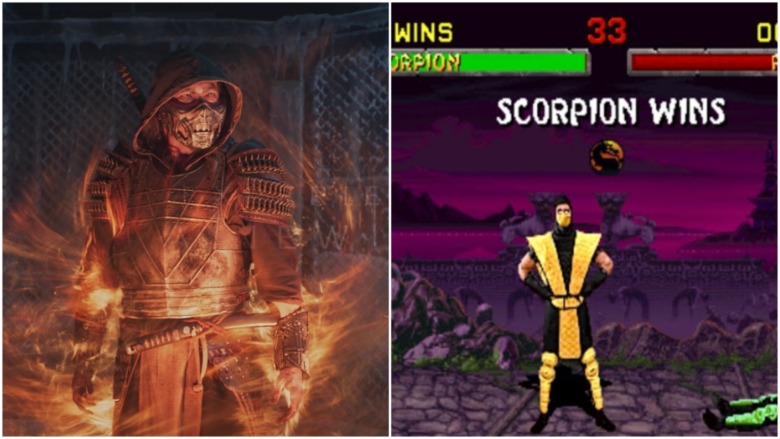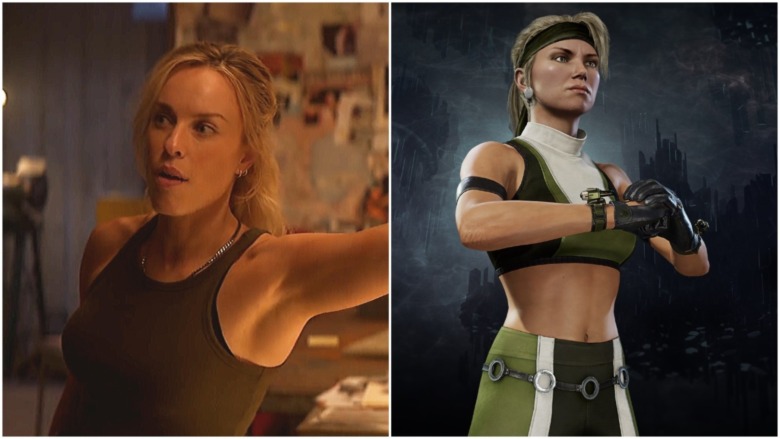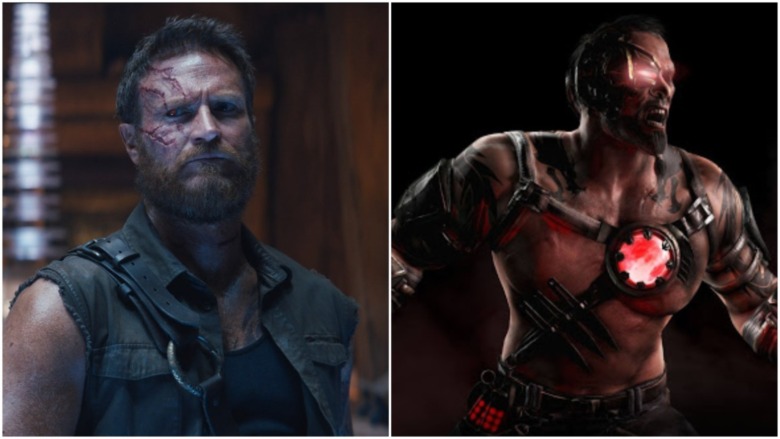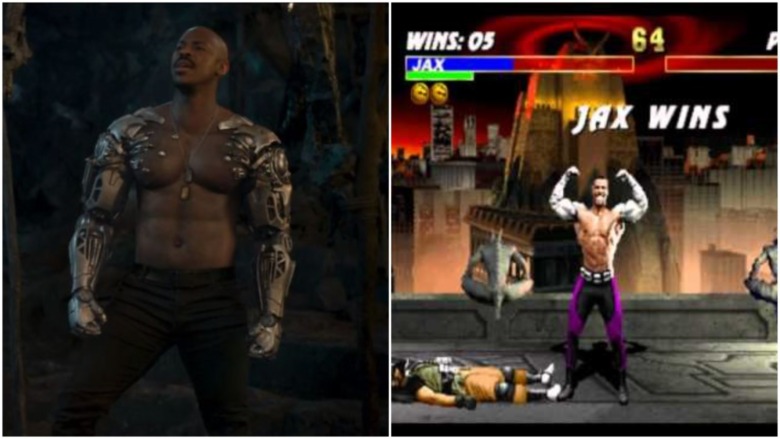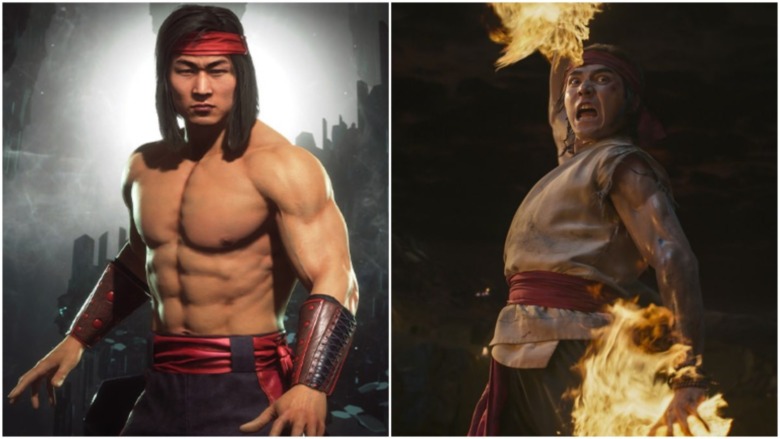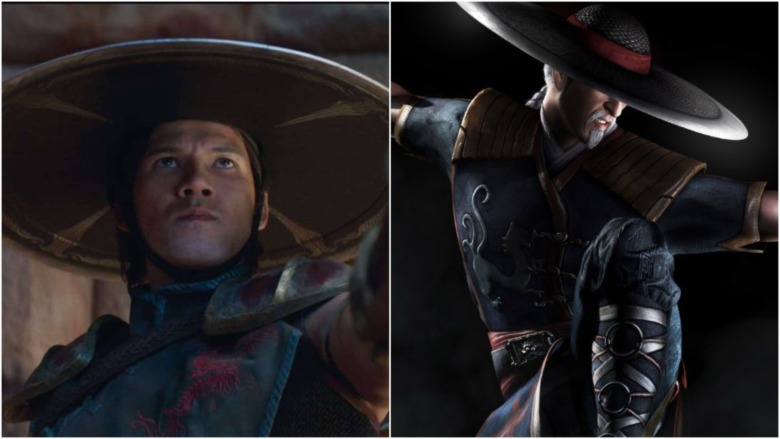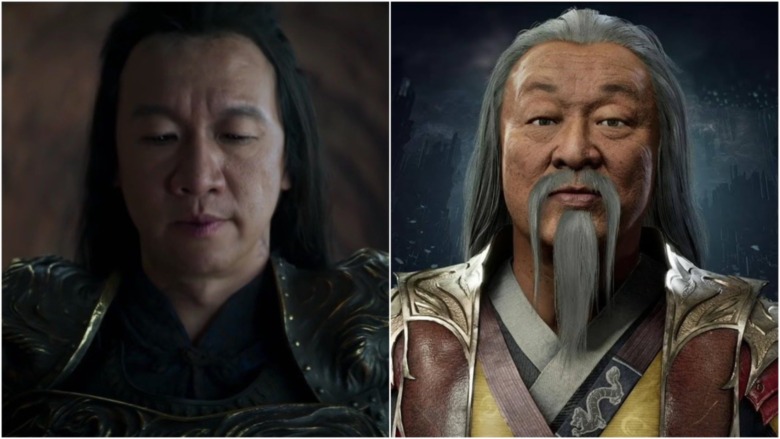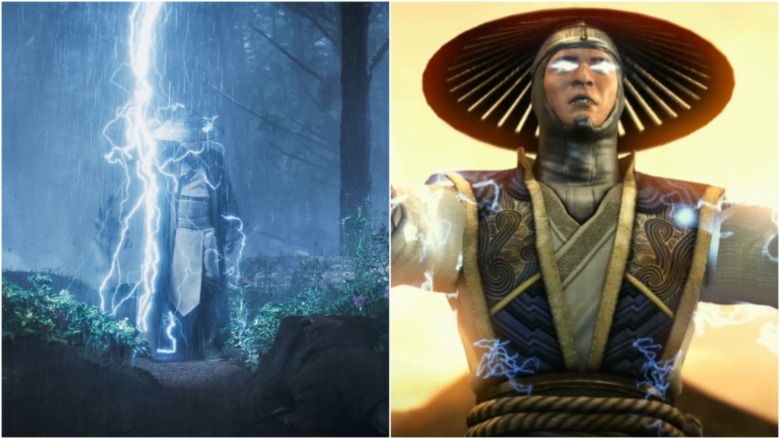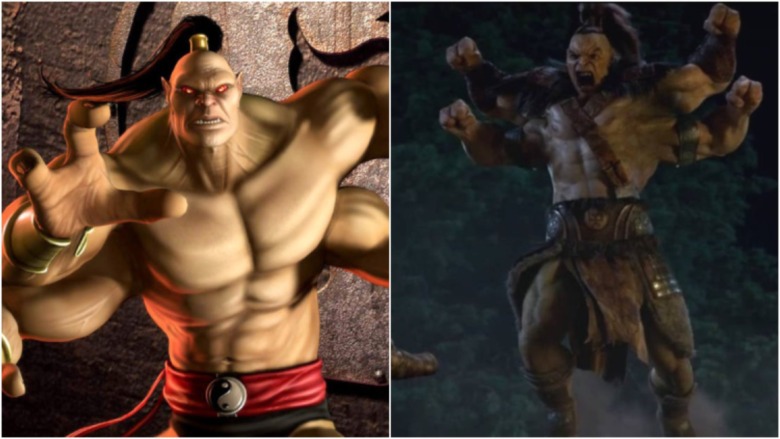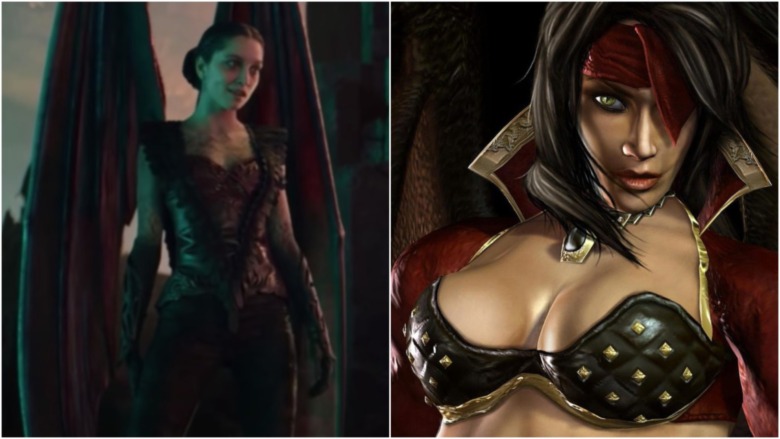How The Characters In The Mortal Kombat Movie Are Different Than The Game
Over the past few decades, "Mortal Kombat" fans have encountered many different versions of the franchise's central characters. Featured in over a dozen games, hundreds of comics, and multiple movies, these fighters, monks, and sorcerers are the gruesomely beating heart (and perhaps also the gorily protruding spine) of fighting games as a whole. Their story has been furthered by the latest "Mortal Kombat" movie, released in 2021: Six of the original seven "Mortal Kombat" characters bring the heat in this film, with the seventh set up to appear in a sequel.
First-time feature director Simon McQuoid's reboot of the "Mortal Kombat" movie franchise isn't exactly a flawless victory, and fans have a wide variety of opinions as to its successes and failures. But it does get most of the defining features of these classic (or should we say klassic?) characters right. Moreover, as an original story, it adds new wrinkles to some of their backstories. Whether you think 2021's "Mortal Kombat" misses the mark when it comes to capturing the fighters' essences or succeeds with flying colors, we can all agree on one thing: These heroes and villains have been changed in the jump to the silver screen. Here are all the ways the characters in "Mortal Kombat" differ from their incarnations in the games.
Fair warning: Spoilers for the "Mortal Kombat" movie and game series follow.
This Sub-Zero isn't the one gamers know
Sub-Zero has become a standard-bearer of the "Mortal Kombat" series, to the point that the phrase "Mortal Kombat" likely conjures his enigmatically masked face in many fans' minds. He's appeared as a playable fighter in every single new "Mortal Kombat" game since the very first one arrived in arcades in 1992. So it makes sense that Sub-Zero freeze-blasts his way on to the silver screen as the 2021 movie's primary villain. But there's a little detail about this cinematic Sub-Zero most viewers aren't going to pick up on, which reveals him to be a different Sub-Zero than the one featured in the modern slate of "Mortal Kombat" games.
Sub-Zero begins the movie under his given name, Bi-Han. But Bi-Han is not the Sub-Zero most "Mortal Kombat" players know and love, unless their frame of reference is rigidly rooted in the early '90s. Indeed, Bi-Han is the original Sub-Zero, featured in the very first "Mortal Kombat" game. But in that inaugural game, Scorpion kills Bi-Han. In subsequent entries, his younger brother, Kuai Liang, takes up the Sub-Zero mantle. It is Kuai Liang, rather than Bi-Han, who appears as Sub-Zero in pretty much every game since 1993's "Mortal Kombat II." The exception to this occurs in the 2011 "Mortal Kombat" game, in which both versions of the character are featured.
Scorpion's surprising family legacy
Scorpion's origins are humble: His first design is exactly the same as Sub-Zero's, save for his yellow color scheme. Since those early days, however, Scorpion has gone on to become one of the most iconic "Mortal Kombat" characters around, second only to his icy counterpart. He goes by his birth name, Hanzo Hasashi, for most of the 2021 movie, and isn't featured as heavily as many fans might have been expecting. In fact, he dies in the prologue, and doesn't reappear until he gets his revenge on Sub-Zero in the final minutes of the film.
There are two key differences between Scorpion in the new "Mortal Kombat" movie and Scorpion in the "Mortal Kombat" games. In the first game, as in the movie, Scorpion is driven to hunt down Sub-Zero after the cryomancer kills his family ... or so he believes. According to the games' lore, it is actually Netherrealm demon Quan Chi who commits the atrocious murder — but Scorpion doesn't learn this until multiple entries later.
Related to this point is the second key difference between the cinematic Scorpion and his game-bound counterpart. The movie introduces a major new twist to his origin: A surviving heir. In 2021's "Mortal Kombat," Hanzo's youngest daughter manages to survive the massacre, and goes on to continue a bloodline that eventually results in the birth of Cole.
Sonya Blade is on a journey to earn her dragon mark
Aside from newbie Cole and his family, Sonya Blade is the only classic "Mortal Kombat" character to get a brand new character arc in the 2021 film. This movie brings a new facet to the complex lore of "Mortal Kombat:" The dragon mark. The dragon mark is a small brand in the shape of the "Mortal Kombat" logo, and is what designates fighters as kombatants and gives them their arcana-based powers.
Cole is born with his dragon mark, but many of the movie's fighters earn theirs in the only other way a person might hope to do so: They kill someone who already has the mark. When we meet Sonya early on, she is unmarked. Any "Mortal Kombat" fan could tell you that it's not a group of Earthrealm protectors without Sonya Blade, so it's not a surprise that this state of affairs doesn't last. This is the core of Sonya's story in "Mortal Kombat:" Her journey ends when she takes the dragon mark from Kano by killing him with a pretty gnarly stab through the head. He's a suitable victim for Sonya, given their long-running rivalry in the "Mortal Kombat" games and comics.
Kano's murky morality
Kano, as depicted in the 2021 movie, is a foul-mouthed mercenary who feels very much in keeping with the spirit of the game character ... with one notable exception. The vast majority of the "Mortal Kombat" games' storytelling positions Kano as the nemesis of Sonya Blade and Jax. So yeah, it's a bit of a twist to see him helping train Cole in the 2021 film. Or is it? We hate to ruin the fun and suspense, but any "Mortal Kombat" fan worth their salt can told you that Kano is the master of betrayal. Without completely giving away the details of the movie, let's just say that "Mortal Kombat" delivers on Kano and Sonya Blade's rivalry, and makes Kano the lovable scumbag he truly is.
Another interesting difference between Kano of the movie and Kano of the games lies in his status within the Black Dragon clan: In the current timeline of the games, Kano is the group's leader, but in the new film, he is merely a member. There's still plenty of time for him to climb the ranks, however — or just murder his way to the top. The only other thing missing is his cybernetic heart, which allows him to shoot out blasts from his chest to annihilate his foes. Hopefully, we'll be seeing a little of that action in subsequent "Mortal Kombat" movies.
Jax earns his arms
Of all the main characters featured in 2021's "Mortal Kombat," Jax is the only fighter who isn't part of the first game's roster. Introduced in "Mortal Kombat II," special forces agent Jax Briggs instantly immortalized himself, and has appeared as a playable character in almost every "Mortal Kombat" game since. Unless you haven't touched the series since his introduction in "MK II," you probably noticed something off about Jax at the start of the movie ... or, to be specific, two things.
That's right: In the movie, Jax has normal (if shredded) arms! Ever since "Mortal Kombat III," Jax has been known best for his titanium, cybernetic arms, which allow him to go toe-to-toe with dark sorcerers and outright gods. This might seem like a shocking departure few fans would be able to embrace, let alone get excited about, but consider this: Now we get to see this transformation happen, in all its gory glory. in this rendition of the "Mortal Kombat" story, it is Sub-Zero who brutally freezes and dismembers Jax. He gets his shiny synthetic limbs just in time to kick plenty of Outworld butt and absolutely destroy Reiko with his iconic "head clap" fatality.
Liu Kang takes on the role of mentor
A warrior monk and champion of Earthrealm, Liu Kang usually acts as the protagonist of the "Mortal Kombat" game series. This was directly translated to film in the original 1995 "Mortal Kombat" movie. The 2021 film, in contrast, introduces Cole Young as the new main character, pushing Liu Kang into a mentor role. This is a serious departure from the much larger role Liu Kang typically plays in "Mortal Kombat" stories, which is made even more dramatic by the fact that this "chosen one" takes a backseat to many other major players in the film.
Liu Kang's design in the 2021 movie is inspired by his look in the early "Mortal Kombat" games, as is the case with many of the film's other fighters. Noticeably absent from his cinematic arsenal are the nunchaku he uses as a weapon in the PlayStation 2 trilogy of 3D "Mortal Kombat" games. Those nunchaku were recently brought back as Kang's primary weapon in 2019's "Mortal Kombat 11." Anyone who has only checked out that very recent game will find Liu Kang's silver screen fighting style to be quite different from what they've come to expect.
A new relationship for Kung Lao and Liu Kang
Slicing through his opponents with his unforgettable wide-brimmed hat, Shaolin monk Kung Lao does a whole lot of killing and not much talking in 2021's "Mortal Kombat". That's far from a complaint: We're all here for the action, after all. The new movie thankfully ticks most of the necessary boxes when it comes to this fan-favorite character. His iconic hat, famously inspired by alpha-henchman Oddjob's topper in 1964's "Goldfinger," is a bloody tour-de-force. Mentioned too is his lineage: He is a descendant of the Great Kung Lao, legendary champion of Earthrealm.
It's not all razor-sharp hats and Shaolin-style beat-downs for Kung Lao, however: One of the lesser-known aspects of this character is that he's the most outspoken pacifist of the Kombatants. This detail is left out of the 2021 movie. Admittedly, it is a tough pill to swallow in the first place, given the bloody history of "Mortal Kombat," and the fact that the selling point of this movie is letting fans see all their favorite characters engage in the violence that made them famous. Still, it's a difference diehard fans will notice.
The 2021 film also adds another new wrinkle to the mythology of "Mortal Kombat:" Here, Kung Lao and Liu Kang are cousins. Fans are doubtlessly very curious to see how this new relationship will pay off in potential future sequels.
Shang Tsung gets a new wardrobe and role
Antagonist Shang Tsung doesn't take up much screen time at all in the 2021 film, despite the weighty fact that he's Liu Kang's rival and the main villain of the first "Mortal Kombat" game. Speaking of Liu Kang, due to his smaller role as a mentor in "Mortal Kombat" rather than the protagonist he's historically been, his rivalry with Shang Tsung isn't emphasized. Absent too is any mention of Tsung's origin as a Chinese human born in Earthrealm, who was given his powers over dark sorcery by Outworld emperor Shao Kahn.
That's not where the differences end, either. Aesthetically, the Shang Tsung we see in the movie doesn't resemble any of the Shang Tsungs we've seen in the "Mortal Kombat" games. Shang Tsung of the games is said to have been based on Lo Pan, the villain of John Carpenter's beloved film, "Big Trouble in Little China." In the 2021 "Mortal Kombat" film, however, Shang Tsung is decked out in heavy armor that does not remotely resemble the light robes he wears in the games. The only characteristic the "Mortal Kombat" movie nails regarding Shang Tsung is his insatiable thirst for human souls.
Raiden doesn't get to fight in the tournament
Unlike the other "Mortal Kombat" arcade fighters who make up the cast of the 2021 movie, Raiden doesn't get a whole lot of time in the ring. In fact, he doesn't get to fight much at all ... unless you count the end, where he lighting-shocks Shang Tsung back to Outworld. Referred to by Liu Kang and Kung Lao only as Lord Raiden, the god of thunder ends up in a similar place as Shang Tsung does in this film, albeit heroically: They both take a bit of a backseat to the action.
Raiden is the leader and the eldest of the Earthrealm protectors in the film. When it comes to the games, however, he's a lot more important: Raiden is one of the few characters who makes an appearance in every "Mortal Kombat" game (and is playable in all, except "Mortal Kombat 3"). While this god only has a small role in the film, his silver screen design definitely resembles the Raiden we see in most "Mortal Kombat" games. He's got his defining straw hat and his unmistakable robe ensemble — really, it's all but identical to what he sports in recent "Mortal Kombat" games. It would have been nice to see him flash his moves while wearing these classic duds, but you can't have everything you want ... even when you're a thunder god.
Goro loses his prestige — and his fireballs
A four-armed Shokan from Outworld, Goro is one of the most instantly recognizable "Mortal Kombat" characters ever designed. In the 1995 movie — his other cinematic appearance — Goro is portrayed by actor Tom Woodruff (with actors Kevin Michael Richardson and Frank Welker providing Goro's speaking voice and vocal effects, respectively) wearing a mind-bogglingly complex costume. The suit weighed roughly 125 pounds, and was operated through a complicated combination of puppetry, animatronics, and Woodruff's own physicality. Though 1995's Goro looks dated to modern eyes, it's hard not to be impressed by the sheer volume of practical effects work that went into creating him. The 2021 reboot, in contrast, takes the opposite approach, going full-on CGI. This new, digitally smooth Goro gets an introduction and a short fight scene that sees him go up against Cole.
Not much is explained about Goro in "Mortal Kombat," and as a result, plenty of fun backstory is omitted. In the game series' lore, Goro is the one who killed the Great Kung Lao, ancestor to the hat-throwing Kung Lao of the main timeline. This makes Goro a legendary warrior, but such prestige doesn't come across at all in the 2021 film — instead, he feels like a henchman. Also noticeably absent to anyone who mains Goro in the game series are the green fireballs he is known to shoot from his arm and mouth.
Nitara's appearance was given a major overhaul
The single deepest cut the 2021 "Mortal Kombat" movie makes in terms of characters has got to be Nitara, the vampire from "Mortal Kombat: Deadly Alliance." Introduced in the fifth main game of the series, only ever appearing again as a playable character in "Mortal Kombat: Armageddon," Nitara was an inspired choice for sure. Yet the Nitara of the silver screen is not exactly the Nitara of the games. Most notably, the new movie makes a few modernizing edits to her aesthetic.
For starters, her outfit is a lot less revealing: The movie's Nitara even covers her midriff. As she was developed at the height of the 1990s, a peak era in terms of video games' sexualization of women, this was probably a good idea. Secondly, her red bandana, which doubles as an eye-patch for her left eye, is nowhere to be found. Aside from her bat-like wings, Nitara's signature look rests upon the bandana and the charm she wears around her neck, which allows her to warp between realms. Both of these defining accessories are completely missing from the film.
